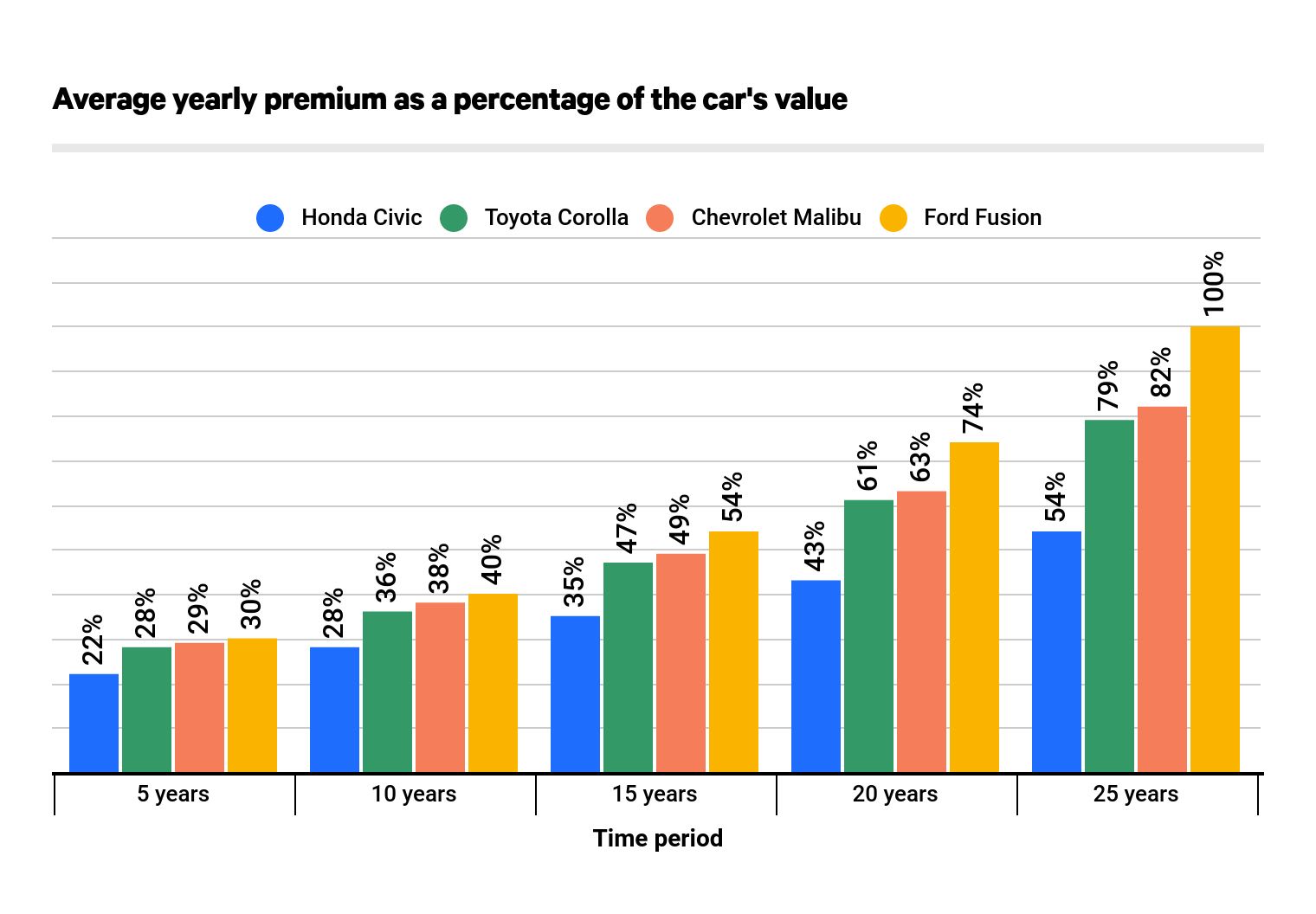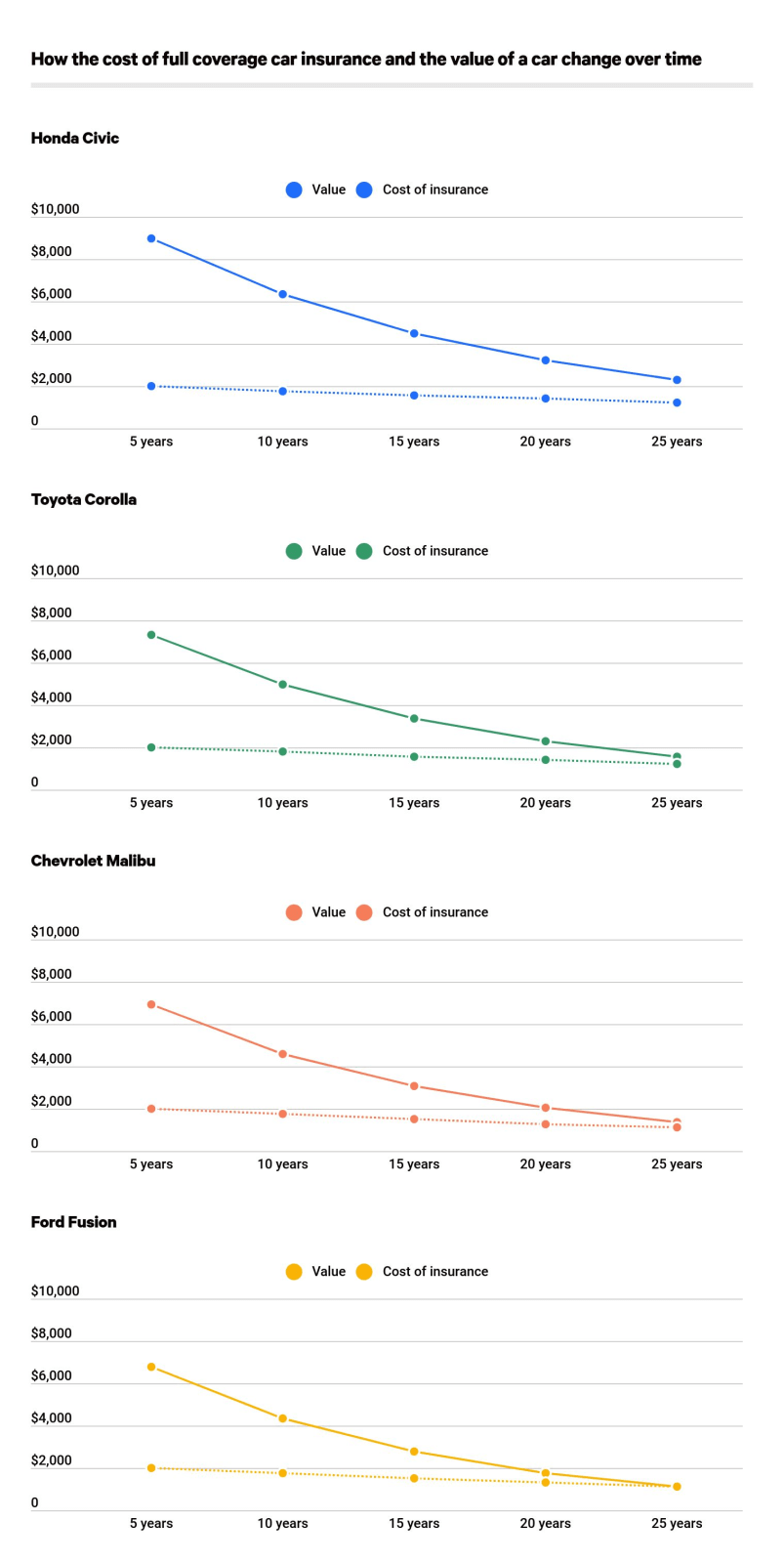How Much Car Insurance Do I Need Domain_10
Full coverage car insurance is an effective way for drivers to replace their vehicles after an accident without having to pay the entire cost of a new car.
However, ValuePenguin discovered that after a car is more than 10 years old, it may be a better investment to switch to liability-only coverage car insurance or consider purchasing a newer vehicle.
According to an analysis of how the cost of insurance and the value of a car change over time, the annual cost of carrying full coverage car insurance on a midsize vehicle can approach 50% of the car's value after more than a decade. Moreover, the combined cost of car insurance and the deductible you have to pay for an at-fault accident is likely to be more expensive than the value of your vehicle if it's more than 10 model years old.
Key findings
- Full coverage car insurance is likely to be a poor investment for vehicles that are more than 10 years old . After this period, the annual cost of insurance represents 46% of the value of older-model vehicles.
- After an at-fault crash, premiums are very likely to exceed the value of vehicles that are 15 or more years old . Depending on the brand of car and type of crash, it may be a better decision to purchase a new vehicle after the crash instead of using insurance to replace a totaled vehicle.
- Factoring in the cost of a typical surcharge after an accident, the difference between a yearly premium and the value of a vehicle is often less than $1,000 for cars older than 10 years .
- The cost to insure midsize sedans is fairly uniform, but newer and older Honda Civic vehicles were the most expensive to insure across major providers.

Full coverage insurance for older cars is often too expensive
A comparison of the cost of insurance and the value of an insured vehicle reveals that full coverage is a worthwhile investment for cars that are a decade old or newer. On average, the cost of insuring a 5-year-old midsize car with a full coverage policy is $2,010 a year. However, the average value of these cars is $7,501.
More importantly, if your car was totaled and you had to make a car insurance claim, it would still be practical to replace your car after an at-fault accident — one where you were responsible for the crash and would have to rely on your comprehensive or collision coverage to reimburse you for expenses — if it were a decade old or newer, even considering the future cost hike and deductible.
What is a deductible? A deductible is the amount you have to pay before your insurance begins paying for losses, such as damage that's covered by your car insurance's comprehensive and collision provisions. In this study, the sample policyholder was responsible for a $500 deductible, but your deductible could be upward of $2,000.
ValuePenguin calculated that the typical cost of insurance for a midsize car increases by 93% after an at-fault accident. When factoring in the cost of the deductible, the annual cost of insuring a 5-year-old car inflates to $4,389, on average. Although the new insurance rate in this situation would amount to 59% of the car's value, drivers would save $3,111 compared to the cost of replacing the wrecked car out of pocket. This is more than the $3,000 or less that more than half of U.S. consumers have in their savings and checking accounts, according to the Consumer Financial Protection Bureau.

After a decade, however, the upside of carrying full coverage for a vehicle diminishes. Ten-year-old cars have an average value of $5,067 and cost $1,758 a year to insure before an accident. Insurance premiums equate to 35% of the car's value for drivers with clean records but increase to 79% after a crash.
In other words, just $1,131 — which includes the deductible — separates the value of a decade-old car from the cost to insure it. In our analysis, the gap between the cost to insure a Honda Civic and its value was $2,405, but models from Ford, Chevrolet and Toyota fared more poorly. For the Fusion, Malibu and Corolla, the value of one's vehicle was only $706 more than the insurance cost.
For some drivers, it may be more economical to pay for a newer car out of pocket than it would be to commit to higher future insurance premiums after an accident.
Between 10 and 15 years after a vehicle's model year, full coverage is a poor investment. While the cost of full coverage by itself likely won't be more than what a car is worth, the cost of insurance is more likely to be higher than the value of the car after an accident. The cost of insuring a 15-year-old car after an accident represents 105% of the car's value, on average.
As one's car ages, it becomes increasingly difficult to justify paying for full coverage. A driver would pay higher premiums for full coverage only to be unable to use their insurance to fully cover the cost to replace their car if it were totaled. After two decades, the cost of full coverage car insurance would equal 141% of a vehicle's value. After 25 years, ValuePenguin estimates that the cost of full coverage insurance would be 188% of the car's value.
Benefits of switching to minimum coverage insurance
It's financially smart to keep car insurance that includes comprehensive and collision coverages on vehicles that are younger than a decade. The cost of insuring a 5-year-old car equates to 27% of the car's value.

After 10 years, the annual cost of car insurance represents 35% of a typical car's value. While we don't expect that the cost of insuring a car will eclipse the value of the vehicle until it's more than 25 years old, the premiums one pays take up a larger proportion of the vehicle's value as time goes on. For major brands, vehicles that are between 20 and 25 years old could see insurance prices that equal more than three-fourths of their vehicle's value.
For instance, the cost of insurance on a 15-year-old car totals 46% of thea car's value, while the driver of a 20-year-old car could pay rates that add up to 60% of their vehicle's value. In fact, depending on the make and model of the car, the size of one's insurance premium varies. We discovered that insuring a 25-year-old Ford Fusion could cost 100% of the car's value before any claims were made on the policy.
As an alternative to purchasing a new vehicle, drivers (especially those without a history of accidents or citations) may find it to be a better investment to switch to a minimum coverage policy — one that offers only liability coverage. Under a minimum coverage policy, a driver's insurance would only pay for damage they caused to another person. In return for less protection, the rates for a minimum coverage policy are much cheaper than those for full coverage.
Cars models that hold the most value
Our analysis revealed that the Honda Civic depreciated in value at a rate of 29% per five years, on average. This was the lowest rate of depreciation compared to the Toyota Corolla, Chevrolet Malibu and Ford Fusion, which were likely to lose 34% of their value year over year, on average.
We found that buying full coverage for a Civic was also the best investment over a 15-year time period. After 15 years and one at-fault claim, the value of a Civic was still $947 more than the cost of insurance. All other models at this age were likely to be more expensive to insure than what they were worth.
Conversely, when comparing car insurance rates with its competitors, we found that the Honda Civic was the most likely to see higher insurance prices. ValuePenguin found that the cost of auto insurance for a Honda Civic would decrease by just 11% per five-year period of the car's lifetime. By comparison, the cost of insuring the Toyota, Chevrolet and Ford models decreased by 13% during the same period.
Frequently asked questions
Are older cars cheaper to insure?
Yes, most older cars are cheaper to insure, especially in terms of comprehensive and collision insurance. Cars lose value as they age, so the potential insurance payouts after an accident drop as well. This is not the case with many classic or collector cars.
Should I have full coverage on a 15-year-old car?
Most of the time, it isn't a good use of money to have full coverage on an older car. After an accident, you will likely get the actual cash value of the vehicle, which is usually not that much more than the extra cost of the insurance.
Can I get full coverage on an old car?
You can get full coverage on an older car. It might not be particularly worthwhile, as premiums will approach or sometimes exceed the value of the vehicle.
How much car insurance do I need for an older car?
The only insurance you usually need is liability coverage and, in some states, personal injury protection. Full coverage is often recommended, but it becomes much less valuable financially with an older car.
Methodology
ValuePenguin gathered car insurance rates for drivers of midsize sedans from the country's top-selling brands in California. We got quotes for a Honda Civic, Toyota Corolla, Ford Fusion and Chevrolet Malibu. We used Kelley Blue Book's Fair Purchase Price to determine the reasonable value of these vehicles. We checked how the value of these vehicles and the annual cost to insure them changed from 2010 to 2015 to 2020 in order to find an average rate of decay.
With this rate of decay in mind, we projected the cost of insurance and the value of each vehicle after five, 10, 15, 20 and 25 years to estimate the point when full coverage becomes too costly compared to the value of the vehicle before and after an at-fault accident.
ValuePenguin's analysis used insurance rate data from Quadrant Information Services. These rates were publicly sourced from insurer filings and should be used for comparative purposes only, as your own quotes may be different.
How Much Car Insurance Do I Need Domain_10
Source: https://www.valuepenguin.com/how-cost-of-car-insurance-changes-with-age-of-car

0 Response to "How Much Car Insurance Do I Need Domain_10"
Post a Comment